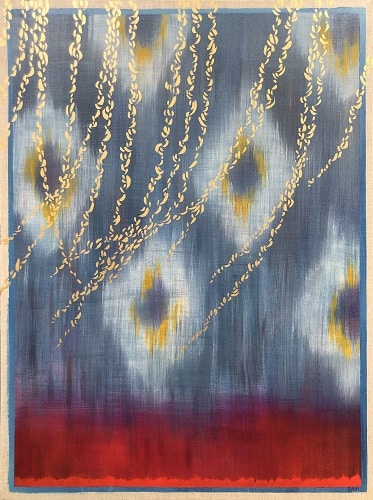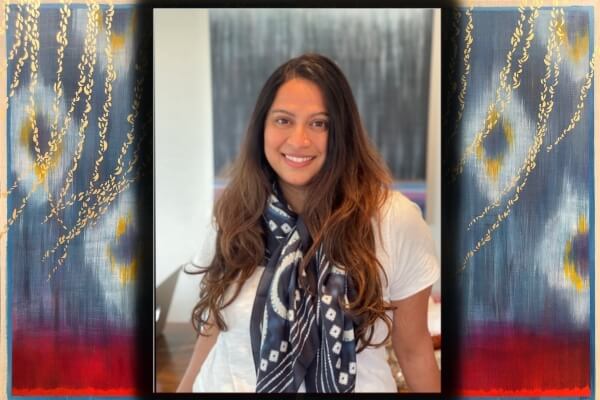When I first walked past Gauri’s exhibit at The Other Art Fair, I was struck by how evocative her paintings were of my grandmother and mother’s old saris. Tempted to reach out and touch the canvas, I expected to feel fine handwoven silk threads. Even upon closer inspection, it was almost impossible to believe that the crosshatch of two different colours coming together was paint, and not fabric.
In Tracing Patterns and Chasing Silhouettes, Gauri’s fascination with patterns and motifs of the Indian world collide with the silhouettes of the plants (such as golden wattle) seen along the river of the lower North Shore.
She draws inspiration from her love of saris and the colour gold, using the latter more liberally in this body of work than she has in the past.
“I’ve always used gold very carefully, very timidly, but now for this work I have gone very bold,” Gauri admits. Gauri Torgalkar’s art
This exhibit has a harmonious, cohesive and familiar colour palate. The central work is titled The willow and the ikkat night sky, and Gauri explains how she painstakingly mimics a loom with her brush, layering thin washes of acrylic paint at right angles and builds these up over time to achieve the remarkably realistic ikkat effect.
“That sense of handloom, those hand-touched imperfections – I wanted to carry it all into the painting,” Gauri reveals. “All of these paintings have 10, 15, sometimes 20 layers of paint slowly built up.”
Gauri typically superimposes the Indian culture and its bold use of colour and motif onto various elements of nature.

This theme is continued from her very first exhibition, Strange Familiar in which Gauri drew together the familiarity of Indian rituals for an Indian diaspora with the uniquely Australian landscape, seen most notably in the painting titled And just for a moment the Parramatta river becomes the Ganges. She reflects that her art has evolved over time within this theme, and this evolution can be seen in the body of work entitled Pagodas – the parallels between the enchanting rock formations in the Blue Mountains with the gopurams of Indian temples, depicted across numerous canvases.
With regards to the theme evolving over numerous bodies of work, Gauri reflects, “It is a continuing language that I am trying to develop.”
She cites Latvian-American abstract painter Mark Rothko and Indian-American artist Natvar Bhavsar as major influences. Both are known for their use of bright colours.
“These are two artists who I just adore, because for me colour is just everything. I have an emotional response to colour! Their art is big and immersive and I like that… they make me think in terms of abstraction.”
Gauri herself only seriously entertained the idea of becoming a professional artist at the age of 34 – having trained and worked as an architect before then – but was able to visualise what her art would look like from early on. She empathises the importance of creating art to please herself, and not for a particular audience. It’s an attitude that’s helped her create an impressive body of work to date.
Participating in The Other Art Fair suited perfectly, given is a fresh, exciting space for artists to showcase their work direct to art lovers of all backgrounds, with an aim to make art more accessible. With international offshoots as well, the Sydney event was held from the 12-15th October, 2023, at the expansive space of The Cutaway in Barangaroo.
Previously, Gauri had won a Create NSW Small Projects Grant in 2022, and has held exhibitions at prestigious galleries both within Australia and Internationally.
Gauri Torgalkar’s art and her collection to date can be viewed on her website and Instagram handle @gauritorgalkar
Read More: Gauri Torgalkar: An Australian floral tribute to Diwali





